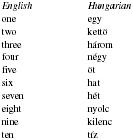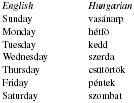Hungarians
PRONUNCIATION: hun-GARE-ee-uns
ALTERNATE NAMES: Magyars (Ethnic Hungarians)
LOCATION: Hungary
POPULATION: 10 million
LANGUAGE: Hungarian (Magyar); German
RELIGION: Roman Catholicism; Reformed Calvinist; Lutheranism; Judaism; Eastern Orthodox Church; other Protestant sects
1 • INTRODUCTION
Hungary is a landlocked nation in central Europe. The western portion of present-day Hungary was conquered by the Romans in 9 BC . The Magyars, who invaded the region in AD 896, were converted to Christianity at the beginning of the eleventh century by King Stephen, who remains a national hero. Turkish rule, beginning in the sixteenth century, was followed by union with the Austrian Hapsburg empire, which lasted until World War I (1914–18).
After over forty years behind the communist "Iron Curtain," Hungary held its first free elections in 1990 and began transforming its economy under Prime Minister Jozsef Antall. Hungary became an associate member of the European Union in 1994.
2 • LOCATION
Although its neighbors' political boundaries were redrawn in the early 1990s, Hungary's territory remained unchanged. It consists of four major regions: the Danube River valley, the Great Plain, the Lake Balaton region, and the Northern Mountains. Ethnic Hungarians, or Magyars, make up the majority of Hungary's 10 million people.
3 • LANGUAGE
The Hungarian, or Magyar, language is universally spoken in Hungary. It is a Finno-Ugric rather than an Indo-European language. Thus it has almost no resemblance to such Western languages as English, French, Spanish, or German. Instead, it is more like Finnish, Estonian, and a few languages spoken in remote parts of Russia.

| English | Hungarian |
| one | egy |
| two | kettö |
| three | három |
| four | négy |
| five | öt |
| six | hat |
| seven | hét |
| eight | nyolc |
| nine | kilenc |
| ten | tíz |

| English | Hungarian |
| Sunday | vasánarp |
| Monday | hétfö |
| Tuesday | kedd |
| Wednesday | szerda |
| Thursday | csütörtök |
| Friday | péntek |
| Saturday | szombat |
4 • FOLKLORE
For the most part, the traditional folklore of Hungary is dying out. One religious tradition revived in some rural areas is the Eastertime fertility ritual of locsolkodas . Boys and men sprinkle water or perfume on girls and receive a painted Easter egg in return.
5 • RELIGION
About two-thirds of Hungarians are Roman Catholic. In general, the Hungarians are not a deeply religious people. The dominant religion of their country changed several times under different rulers. Thus the Hungarians are known for being more tolerant about religion than many of their neighbors.
6 • MAJOR HOLIDAYS
New Year's (January 1), or Farsang, begins a season of formal dances and parties throughout the country that lasts until Ash Wednesday (sometime in February). On March 15, the 1848–49 Revolution is commemorated with speeches, flag-waving, and parades. Easter Monday (late March or early April) is the most important religious holiday in Hungary.
May Day (May 1) is celebrated as a workers' holiday. August 20, St. Stephen's Day, is Hungary's national day, celebrated with fireworks throughout the country. Proclamation of the Republic Day on October 23 commemorates the 1956 uprising against the Communist regime. It is marked by torch-lit processions. Christmas (December 25) and Boxing Day (December 26) are celebrated privately in family gatherings.
Instead of their own birthdays, Hungarians, like people in other primarily Catholic countries, tend to celebrate the feast day of the saint for whom they are named.
7 • RITES OF PASSAGE
Many of the rites of passage that young people undergo in Hungary are Christian rituals such as baptism, first communion, confirmation, and marriage. In addition, many families mark a student's progress through the educational system with graduation parties.
Two special ceremonies mark students' graduation from high school. In February of their senior year, students take part in a ribbon-pinning ceremony called szalagavato. In May, just before final exams, comes the ballagas, or marching ritual. The seniors form a line and march through every classroom singing as the teachers and other students present them with flowers. In embroidered pouches, they carry salt, money, and a pagacsa or small roll, all of which are meant to symbolically support them as they embark on their adult lives.
8 • RELATIONSHIPS
Social interactions in Hungary are formal and polite. Hungarians, especially older men, often greet young women by kissing their hands. Kissing a person's hand as a sign of respect is referred to in the traditional greeting of young people toward their elders ( Csókolom— "I kiss it"). Even close friends shake hands when greeting each other.
Currently, young people like to use the English word "hello" as slang for "goodbye."
9 • LIVING CONDITIONS
After World War II (1939–45), a severe housing shortage developed in Hungary as workers flocked to the cities from rural villages. Most existing apartments had only one room and a kitchen area. Many had been damaged in the war. Those who had to depend on government-funded housing were placed on long waiting lists. There is still a shortage of adequate housing in urban areas.
10 • FAMILY LIFE
Traditionally, both nuclear and extended families were found in rural areas of Hungary. Today, the nuclear family is more common in the country, as well as in urban areas. Hungarians generally marry between the ages of twenty and twenty-four.
Patterns of family life have shifted since World War II (1939–45). The most notable change is the increased number of women working outside the home. By 1987 about 75 percent of women had jobs. In recent decades the divorce rate has risen. About one in every three marriages ends in divorce.
11 • CLOTHING
Hungarians generally wear modern Western-style clothing. Casual wear in the cities includes jeans, T-shirts, and sweatshirts. Pantsuits are popular with both men and women for casual and more formal occasions. In rural areas, one can still see more traditional clothing. Women may wear peasant babushkas (scarves) on their heads, and men may wear hats with floppy brims.
Recipe
Gulyás
(Goulash)
Ingredients
- 3 slices of bacon
- 1½ pounds pork loin, cut into 1-inch cubes
- 1 medium onion, chopped
- ½ teaspoon caraway seeds
- 1 Tablespoon paprika (preferably Hungarian-style paprika)
- 1 can cream of chicken soup
- ¼ cup water
- 3 cups sauerkraut, rinsed and drained
- ½ green pepper, cut into small squares
- 1 tomato, chopped (½ cup chopped canned tomatoes may be substituted)
- ½ cup sour cream
- 2 Tablespoons flour
- Parsley
Directions
- Cook bacon until crisp. Cool on paper towels. Crumble bacon.
- Add pork, onion, caraway seeds, and paprika to pan. Brown pork over medium heat.
- Stir in soup, water, and sauerkraut. Cover pan and simmer over low heat for one hour, stirring occasionally.
- Add green pepper and tomato and simmer 30 minutes more, stirring occasionally.
- Combine sour cream and flour. Stir this combination into the pork mixture. Simmer over low heat, stirring constantly, until thickened.
- Garnish with bacon and parsley.
Serve with rice, egg noodles, or boiled potatoes.
The traditional costumes worn for festivals have fancy, brightly colored embroidery. Women wear white embroidered aprons with lace trim, while men wear plain or embroidered white shirts and dark vests.
12 • FOOD
The Hungarian diet is heavily meat-based. Pork is the most commonly used ingredient. The most famous dish is probably goulash (gulyás). It is a soup or stew made with meat, onions, and potatoes, and seasoned with paprika. Often, other vegetables are added as well. Stews with sour cream are called paprikash . Fish soups (called levesek or halászlé ) are also popular. Popular desserts include pancakes (palacsinta) with dessert fillings (a version of crèpes) and strudel.
13 • EDUCATION
Schools provide eight years of primary and four years of secondary education, and education is required until the age of sixteen. About 40 percent of primary and secondary schools are now run by various religious groups. Institutions of higher learning include four comprehensive universities, fifteen specialized universities, and forty-two specialized colleges.
14 • CULTURAL HERITAGE
One distinctive feature of Hungarian culture is the merging of folk art and fine art. Two notable twentieth-century examples can be found in the compositions of Béla Bartók and the ceramic sculptures of Margit Kovács.
Notable painters include Mihály Munkácsy in the nineteenth century, and Szinyei Merse at the turn of the twentieth century. The famous nineteenth-century composer Franz Liszt was born in Hungary. Much Hungarian literature has been politically inspired. National Song, written by the nation's most celebrated poet, Sándor Petofi, became a rallying cry in the 1848 War of Independence. Famous twentieth-century poets include Endre Ady and Attila József.
15 • EMPLOYMENT
In 1991 nearly one-third of Hungarians were employed in industry, and about one-fifth in agriculture. After the downfall of communism in 1990, unemployment rose from about 2 percent to over 13 percent by 1993. It is not uncommon for Hungarians to hold second and even third jobs. Women account for over 50 percent of the labor force.
16 • SPORTS
Soccer and water polo are both very popular participant sports. Most cities and towns have both indoor and outdoor public pools. Besides soccer, other spectator sports include tennis, skiing, and horse racing.
17 • RECREATION
Hungarians like to relax during their leisure hours by reading, watching television and videos, and playing sports. The most popular spectator sport is soccer (called "foot-ball"). Chess is also popular.
Vacation trips are extremely popular among Hungarians. Most go to the country in August. Many own or have access to summer cottages where they can spend time on weekends or during extended holidays.
18 • CRAFTS AND HOBBIES
Many Hungarian homes are graced by traditional woodcarvings. The weavers of the Sárköz region produce a distinctive red and black fabric, and the Great Plain region is known for its pottery.
Hungarian folk music is known for its pentatonic scale (having five tones to the octave), adapted by such twentieth-century composers as Béla Bartók and Zoltán Kodály. The csárdás is a popular folk dance.
19 • SOCIAL PROBLEMS
The transition from communism to a free-market economy since 1990 has caused much social disruption. Problems include inflation, rapidly growing unemployment, and the failure of many businesses. A severe housing shortage continues to be a fact of life in urban areas. There is widespread discrimination against the Gypsies in employment, housing, and other areas.
20 • BIBLIOGRAPHY
Domjan, Joseph. Hungarian Heroes and Legends. Princeton, N.J.: Van Nostrand, 1963.
Handler, Andrew, and Susan V. Meschel (eds.). Young People Speak: Surviving the Holocaust in Hungary. New York: Franklin Watts, 1993.
Hill, Raymond. Hungary, Nations in Transition. New York: Facts on File, 1997.
Hungary: A Country Study. Washington, D.C.: U.S. Government Printing Office, 1990.
Jackson, Livia Bitton. I Have Lived a Thousand Years: Growing Up in the Holocaust. New York: Simon & Schuster Books for Young Readers, 1997.
Steins, Richard. Hungary, Exploring Cultures of the World. New York: Benchmark Books, 1998.
WEBSITES
Embassy of Hungary. Washington, D.C. [Online] Available http://www.hungaryemb.org/ , 1998.
Hungarian National Tourist Office. [Online] Available http://www.hungarytourism.hu/ , 1998.
World Travel Guide. Hungary. [Online] Available http://www.wtgonline.com/country/hu/gen.html , 1998.
It prepared me immensely for my Hungarian visitors.
Thanks and this website is GREAT !